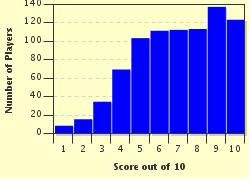Quiz Answer Key and Fun Facts
1. The seventh planet from the sun, Uranus was discovered by William Herschel in which century?
2. Olympus Mons, one of the highest mountains in the Solar System, is located on which planet?
3. Now downgraded to a dwarf planet, Pluto is situated in a region of the Solar System named after which astronomer?
4. The planet Neptune had a region to its left, as seen in the photo, which was known by which of these names?
5. The Hale-Bopp comet was named after its two, independent, discoverers in 1995. What nationality were both these men?
6. The Leonid meteor shower was named for which of these?
7. The Caloris Basin is an impact crater on which planet?
8. Discovered in 2005, the dwarf planet Eris was named for the Greek goddess who represented which of these?
9. The moons of Uranus are named after characters from Shakespeare. Which name was given to the largest moon, discovered in 1787?
10. The main asteroid belt of the Solar System is located between which two planets?
Source: Author
rossian
This quiz was reviewed by FunTrivia editor
CellarDoor before going online.
Any errors found in FunTrivia content are routinely corrected through our feedback system.

